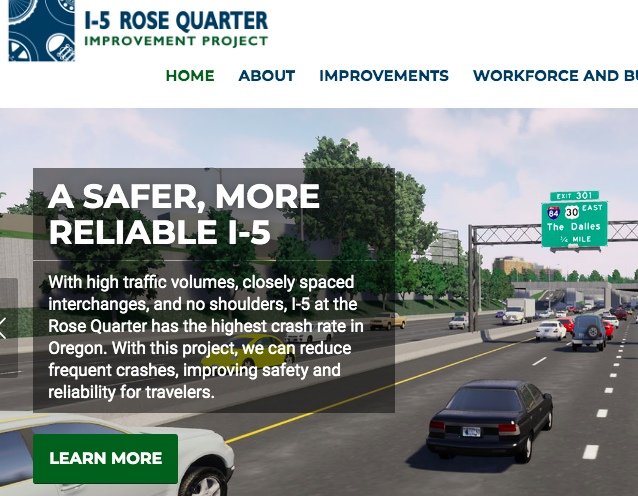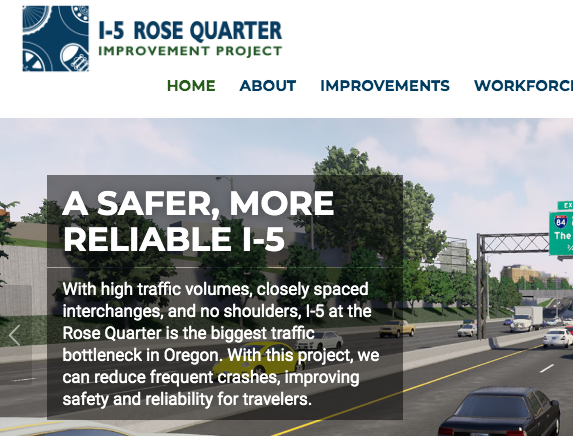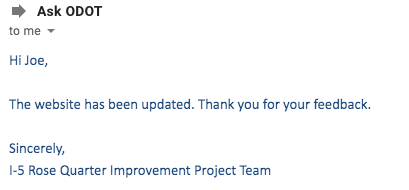Oregon’s Department of Transportation concedes it was lying about crashes on I-5 at the Rose Quarter
For more than a year, we and others have been calling out the Oregon Department of Transportation for its false claims wider freeways are needed to improve road safety. And we’ve repeatedly show that ODOT’s claim that I-5 at the Rose Quarter in Portland is the state’s “#1 Crash Location” is contradicted by ODOT’s own crash data. Willamette Week exposed the lie in a story they wrote in 2017. That lie was an intentionally chosen tag line for the project’s marketing campaign, as ODOT’s internal documents show.
We published our analysis–citing ODOT’s own data proving that wasn’t true–at City Observatory in March of last year.
And then in April, City Observatory Director Joe Cortright testified in person directly to the Oregon Transportation Commission, pointing out the same thing:
 Despite repeatedly being informed of this falsehood by City Observatory (as well as others), the agency never corrected these claims, and continued to say the same thing in public presentations and to the media.
Despite repeatedly being informed of this falsehood by City Observatory (as well as others), the agency never corrected these claims, and continued to say the same thing in public presentations and to the media.
Earlier this month, ODOT’s project website displayed exactly the same false claim.
How we finally got ODOT to retract its lie (at least on its website)
But as of Monday March 2, the website has been changed.
The reason: On February 21, we sent an email to the agency’s “Ask ODOT” email address, which is apparently run by something called the “Citizen’s Representative Office of ODOT.” We emailed “Ask ODOT”, asking why the agency made this false claim. On February 28, the agency replied:
Thank you for your recent question about the I-5 Rose Quarter Improvement Project. In researching your question, we noticed the project website included some inconsistent language regarding the crash rate on I-5 in the Rose Quarter. To clarify, I-5 between I-405 and I-84 has the highest crash rate on an urban interstate in the state of Oregon. This has been corrected– thank you for bringing this to our attention.
Details can be found in the Environmental Assessment, Section 3.14.1.3 and Section 5.1.2 of the Transportation Safety Technical Report. Excerpts from those documents are included below.
That day (February 28), we checked ODOT’s website, and it turns out that the agency had done nothing to correct the headline finding displayed prominently on the website. Anyone who opens the project website gets a short slide show, with one slide featuring this message:

So that same day, we wrote ODOT, asking why once the agency had conceded our point, that it had not revised the website accordingly. On March 2, the agency responded:
Here is the revised website page, shown as it appeared on March 2.. The words “highest crash rate in Oregon” have been deleted.

So, after a year of pointing out their falsehood, ODOT has, in the most grudging way possible, admitted that its been lying about the safety problems of this stretch of I-5. It’s a classic example of what one Oregon legislator referred to as “malicious compliance.” While we’re delighted that the record has been corrected, it shouldn’t have been necessary in the first place, had the agency been honest, and it certainly shouldn’t have required more than a year of repeated attempts to get it to change. And notice that even though the blatant lie has been excised, the image still promotes the project as a safety enhancement, which is at best a dubious claim.
Too little, too late: Too much lying
Its reprehensible that ODOT touts its now $800 million freeway widening project as a safety measure, when the other highways it operates in Portland are far and away more lethal to Oregonians, and when this project will do nothing to stem the rising death toll on Portland area streets and highways. The enormity of this lie was clearly illustrated earlier this month in Michelle DuBarry’s op-ed in The Oregonian. DuBarry lost her child in a road crash in North Portland in 2010. She was at first pleased to hear that ODOT would be devoting hundreds of millions of dollars to improving safety, but then as she learned that it was to go into a wider freeway, she was incensed:
“Finally!” I thought. The agency is going to address the lethal roads it manages across the region: North Lombard Street/North Columbia Boulevard (29 deaths since 2010); Southeast Division Street (23 deaths since 2010); Southeast Powell Boulevard (21 deaths since 2010); Southeast 82nd Avenue (15 deaths since 2010). . . . But my relief turned to confusion once I learned the details of the safety project. Known as the I-5 Rose Quarter Improvement Project, it does not address any of ODOT’s most dangerous roads. Instead, the agency is using taxpayer money to add a lane to both sides of a 1.7 mile stretch of freeway. . .
I don’t know what political mountains need to be moved for the agency to repurpose that money, but I am hoping our local leaders and advocates can apply enough pressure to convince them to invest in real traffic safety. They might start with the intersection of North Lombard Street and North Interstate Avenue where my son was killed in his stroller on a two-block walk from our house to the grocery store. If the state has nearly a billion dollars to invest in safety, surely we can do better than a freeway expansion.
Widening the I-5 freeway has nothing to do with safety. This section of roadway has no fatalities and few serious injuries. Widening the freeway in this area actually led to an increase in crashes following ODOT’s last construction project a decade ago. This isn’t even a new lie: ODOT was shown to be lying when it made exactly this same “highest crash location” claim to market the failed $3 billion Columbia River Crossing. Metro’s Regional Transportation Plan officially describes the the freeway widening’s purpose as to “reduce minor and non-injury crashes.” And all this was no accident or mere “inconsistency.” The claim was intentionally chosen as part of the project’s marketing plans.
It’s a welcome, if minor, concession that someone at ODOT bent to reality and corrected the obvious (and intentional) error on their website. But the fact that the agency embraced this falsehood, and that it continues to characterize an $800 million dollar freeway widening as a “safety” measure shows how relentlessly cynical they are in promoting this project.


